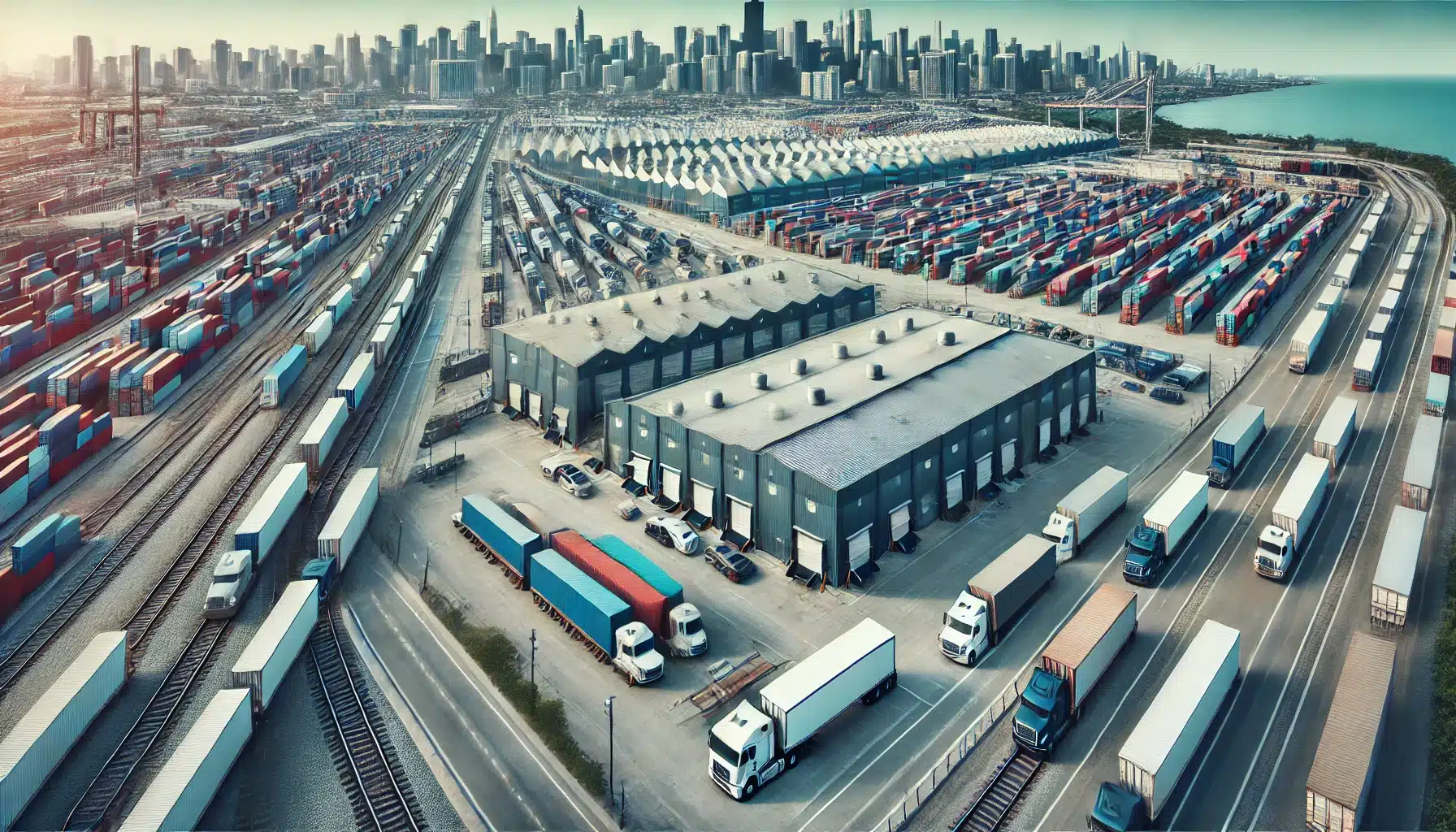How the East Coast Port Strike Could Impact the Chicago Industrial Real Estate Market
As discussion around a potential East Coast port strike continues, businesses across the U.S. are preparing for the potential ripple effects on their supply chains. Ports are critical to global trade, and any disruption, like a strike, could cause significant delays in the movement of goods and materials. While this situation could pose challenges for many sectors, it could also present a unique opportunity for industrial hubs like Chicago.
In this article, we’ll explore the potential impacts of an East Coast port strike on the industrial real estate market, the shift from “Just-in-Time” to “Just-in-Case” inventory strategies, and growing trends like onshoring, reshoring, and regionalization—all of which position Chicago to benefit from these potential disruptions.
The Importance of Ports to Industrial Real Estate
Ports are essential for moving goods that businesses rely on for manufacturing, distribution, and retail. Port performance directly affects industrial real estate, as facilities like warehouses, distribution centers, and intermodal hubs rely on a steady flow of goods. A port strike could disrupt this flow, sending shockwaves through supply chains and impacting the demand for industrial space.
Potential Impacts of an East Coast Port Strike
While the strike hasn’t yet materialized, the possibility is causing companies to reevaluate their logistics strategies. If the strike goes ahead, we could see the following effects:
- Congestion: Ships waiting at ports will be delayed in offloading cargo, causing backups across the supply chain.
- Supply Chain Disruptions: Delays in receiving goods will impact manufacturing, retail, and service industries that rely on timely imports.
- Increased Transportation Costs: As companies shift to alternative logistics routes, transportation costs will rise, adding pressure on industrial real estate needs for efficient distribution.
These potential disruptions could force businesses to look for alternatives, and Chicago, with its extensive infrastructure, could emerge as a key player in this evolving landscape.
Chicago’s Strategic Role in the U.S. Supply Chain
In the event of an East Coast port strike, inland centrally located cities like Chicago could become even more important. Chicagoland’s industrial real estate market is uniquely positioned to benefit, thanks to its well-established rail infrastructure, access to air and road networks, and its ability to serve as a central hub for goods rerouted from other parts of the U.S., including Mexican ports.
1. Chicago’s Rail Infrastructure and Intermodal Facilities
Chicago is home to the largest rail hub in North America, with 25% of U.S. freight rail traffic passing through the city. Six of the seven Class I railroads operate in Chicago, making it a crucial link for goods traveling across the country. If a strike impacts East Coast ports, businesses may increasingly look to rail transport through Chicago to bypass bottlenecks on the coasts.
- Intermodal Facilities: Chicago’s intermodal terminals, where goods transfer between trucks, trains, and air freight, are some of the busiest in the country. If a strike happens, the demand for industrial real estate around these facilities will surge as businesses seek to move goods more efficiently.
2. Mexican Ports and Chicago’s Role as a Distribution Hub
Another potential strike impact is increased reliance on Mexican ports, such as Lázaro Cárdenas and Manzanillo, as alternative entry points for goods. Mexico’s growing trade network and its strategic location on the Pacific Coast provide an important solution for U.S. businesses facing logistical challenges.
- Trade via Rail: Goods arriving at Mexican ports are frequently transferred to rail, passing through the U.S. to hubs like Chicago. This U.S.-Mexico rail network has grown significantly recently, with trade between the two nations expanding by 8.5% annually. If the strike materializes, Chicagoland’s industrial real estate market could see increased demand for storage and distribution as companies reroute their supply chains.
The Shift from “Just-in-Time” to “Just-in-Case” Inventory Strategies
The potential for an East Coast port strike is accelerating a trend we’ve been seeing over the past few years—the shift from Just-in-Time (JIT) to Just-in-Case (JIC) inventory strategies. The JIT model, designed to minimize costs by only holding goods when needed, leaves businesses vulnerable to supply chain disruptions like strikes.
With the possibility of delayed shipments, more companies are adopting the JIC model, which focuses on holding larger inventories to safeguard against potential disruptions. This change has significant implications for industrial real estate, especially in Chicago.
1. Increased Demand for Warehousing Space
The transition to JIC inventory management requires significantly more warehouse space, as companies must hold larger quantities of goods to ensure supply chain continuity. The demand for more storage capacity could lead to a surge in leasing and development activity in Chicagoland’s industrial real estate market.
- Rising Warehouse Leasing Rates: With the potential strike driving up demand for storage, leasing rates in Chicago’s already tight industrial market could rise even further. Developers and investors will need to act quickly to secure prime locations for new warehousing and distribution facilities.
2. Strategic Warehousing Near Transportation Hubs
Businesses adopting the JIC model will need to place their warehouses near major transportation hubs to ensure the efficient movement of goods. Chicago’s proximity to rail, air, and road networks makes it an ideal location for companies that need to hold more extensive inventories and transport them to key markets across the U.S.
Onshoring, Reshoring, and Regionalization: The Return of Domestic Manufacturing
In addition to changes in inventory models, the potential for an East Coast port strike is accelerating trends like onshoring, reshoring, and regionalization. Businesses are increasingly looking to reduce their reliance on overseas supply chains, especially as vulnerabilities like port strikes highlight the risks of offshoring production.
1. Onshoring and Reshoring in Chicago’s Industrial Market
As companies bring manufacturing and production back to the U.S., Chicago is well-positioned to benefit from the growing demand for industrial space. With its central location, access to raw materials, and skilled labor force, Chicago offers an attractive option for businesses looking to reshore operations.
- Reshoring Manufacturing Facilities: The movement of manufacturing back to the U.S. is creating demand for industrial space tailored to production needs. Large-scale facilities near transportation hubs like Chicago are likely to see increased demand, especially in light of potential supply chain disruptions.
2. Regionalization of Supply Chains
Many businesses are also adopting a regionalization strategy, focusing on shorter, more localized supply chains that minimize the risks associated with global trade. Within a day’s drive of one-third of the U.S. population, Chicago’s strategic location makes it a key hub for companies pursuing regionalized supply chains.
How a Potential East Coast Port Strike Presents a Unique Opportunity for Chicago Industrial Real Estate
Even though the East Coast port strike is uncertain, businesses are already preparing for potential disruptions. This, combined with shifts in inventory strategies and the return of domestic manufacturing, creates a perfect storm of opportunities for Chicagoland’s industrial real estate market.
1. Warehousing and Distribution Center Development
The demand for additional warehousing and distribution space could increase as companies adopt JIC inventory strategies and seek inland hubs like Chicago for their storage needs. Investors and developers should focus on acquiring and building industrial properties near key transportation routes, including intermodal hubs and O’Hare International Airport.
2. Intermodal Facilities and Logistics Hubs
As reliance on rail transportation and intermodal systems grows, Chicago’s role as a distribution hub will expand, especially as businesses look for ways to mitigate the impact of the potential strike. Developing or acquiring properties near intermodal facilities will position investors to meet the growing demand for efficient cross-docking and logistics solutions.
3. Onshoring and Manufacturing Space
The resurgence of domestic manufacturing will create demand for industrial space tailored to production. Chicagoland’s industrial real estate market, with its skilled workforce and excellent transportation links, is well-suited to support this shift toward more localized production.
Challenges to Consider
While there are significant opportunities in Chicagoland’s industrial real estate market, there are also some challenges:
- Limited Industrial Space: As demand increases, available industrial space in Chicago could become scarce. Investors will need to act quickly to secure land for new developments.
- Rising Costs: Global supply chain disruptions, labor shortages, and rising material costs could increase the price of new industrial developments.
Conclusion
While the East Coast port strike remains a potential scenario, it has already prompted businesses to reevaluate their logistics strategies. Inland industrial hubs like Chicago are in a strong position to benefit from these disruptions. The shift from Just-in-Time to Just-in-Case inventory models, along with trends like onshoring and reshoring, is driving demand for industrial real estate across the region.
With its extensive transportation infrastructure, access to rail and air cargo networks, and strategic location at the heart of the U.S., Chicago is well-equipped to capitalize on these trends. The time to act is now for industrial real estate investors and developers. Chicagoland’s industrial market is poised to become an even more critical player in the evolving logistics landscape by focusing on warehousing, intermodal facilities, and reshoring manufacturing operations.



